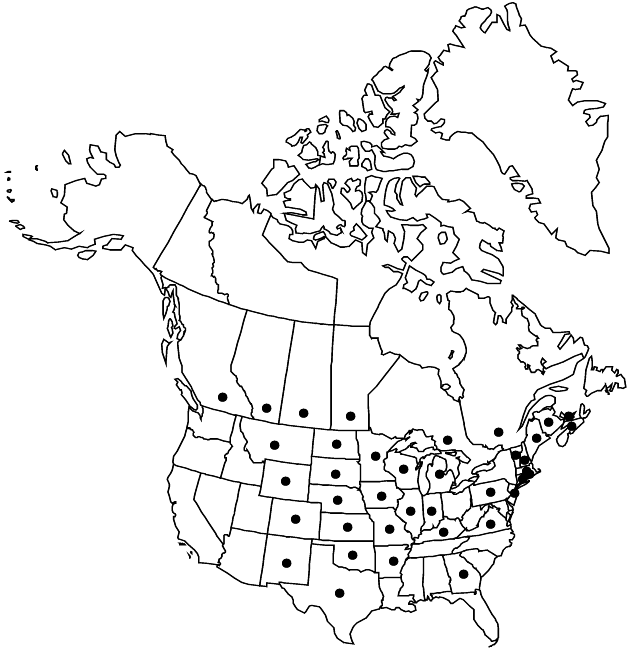Difference between revisions of "Helianthus pauciflorus"
Gen. N. Amer. Pl. 2: 177. 1818.
FNA>Volume Importer |
RevisionBot (talk | contribs) m (Bot: Adding category Revised Since Print) |
||
| (8 intermediate revisions by 3 users not shown) | |||
| Line 6: | Line 6: | ||
|place=2: 177. 1818 | |place=2: 177. 1818 | ||
|year=1818 | |year=1818 | ||
| + | }} | ||
| + | |special_status={{Treatment/ID/Special_status | ||
| + | |code=E | ||
| + | |label=Endemic | ||
}} | }} | ||
|basionyms= | |basionyms= | ||
| Line 19: | Line 23: | ||
-->{{Treatment/Body | -->{{Treatment/Body | ||
| − | |distribution= | + | |distribution=Alta.;B.C.;Man.;N.B.;N.S.;Ont.;P.E.I.;Que.;Sask.;Ark.;Colo.;Conn.;Ga.;Ill.;Ind.;Iowa;Kans.;Ky.;Maine;Mass.;Mich.;Minn.;Mo.;Mont.;N.Dak.;N.H.;N.J.;N.Mex.;Nebr.;Okla.;Pa.;R.I.;S.Dak.;Tex.;Va.;Vt.;Wis.;Wyo. |
|discussion=<p>Subspecies 2 (2 in the flora).</p><!-- | |discussion=<p>Subspecies 2 (2 in the flora).</p><!-- | ||
| − | --><p>Variation within Helianthus pauciflorus is complex and is complicated by hybridization with H. tuberosus. Hybrids with H. tuberosus are known as H. ×laetiflorus, which is frequently cultivated.</p> | + | --><p>Variation within <i>Helianthus pauciflorus</i> is complex and is complicated by hybridization with <i>H. tuberosus</i>. Hybrids with <i>H. tuberosus</i> are known as <i>H. ×laetiflorus</i>, which is frequently cultivated.</p> |
|tables= | |tables= | ||
|references= | |references= | ||
| Line 44: | Line 48: | ||
-->{{#Taxon: | -->{{#Taxon: | ||
name=Helianthus pauciflorus | name=Helianthus pauciflorus | ||
| − | |||
|authority=Nuttall | |authority=Nuttall | ||
|rank=species | |rank=species | ||
| Line 51: | Line 54: | ||
|basionyms= | |basionyms= | ||
|family=Asteraceae | |family=Asteraceae | ||
| − | |distribution= | + | |distribution=Alta.;B.C.;Man.;N.B.;N.S.;Ont.;P.E.I.;Que.;Sask.;Ark.;Colo.;Conn.;Ga.;Ill.;Ind.;Iowa;Kans.;Ky.;Maine;Mass.;Mich.;Minn.;Mo.;Mont.;N.Dak.;N.H.;N.J.;N.Mex.;Nebr.;Okla.;Pa.;R.I.;S.Dak.;Tex.;Va.;Vt.;Wis.;Wyo. |
|reference=None | |reference=None | ||
|publication title=Gen. N. Amer. Pl. | |publication title=Gen. N. Amer. Pl. | ||
|publication year=1818 | |publication year=1818 | ||
| − | |special status= | + | |special status=Endemic |
| − | |source xml=https:// | + | |source xml=https://bitbucket.org/aafc-mbb/fna-data-curation/src/2e0870ddd59836b60bcf96646a41e87ea5a5943a/coarse_grained_fna_xml/V19-20-21/V21_385.xml |
|tribe=Asteraceae tribe Heliantheae | |tribe=Asteraceae tribe Heliantheae | ||
|subtribe=Asteraceae (tribe Heliantheae) subtribe Helianthinae | |subtribe=Asteraceae (tribe Heliantheae) subtribe Helianthinae | ||
| Line 63: | Line 66: | ||
}}<!-- | }}<!-- | ||
| − | -->[[Category:Treatment]][[Category:Helianthus]] | + | --> |
| + | |||
| + | [[Category:Treatment]] | ||
| + | [[Category:Helianthus]] | ||
| + | [[Category:Revised Since Print]] | ||
Latest revision as of 19:25, 6 November 2020
Perennials, 50–200 cm (rhizomatous). Stems erect, scabro-hispid. Leaves mostly basal; opposite, or opposite (proximal) and alternate; petioles 0–1 cm; blades lance-ovate to oblong-lanceolate, or rhombic-ovate to lance-linear, 5–27 × 2–6 cm, bases cuneate, margins serrate to subentire, abaxial faces sparsely hispid, sparsely, if at all, gland-dotted (cauline smaller). Heads 1–10. Peduncles 3–12 cm. Involucres hemispheric, 15–23 mm diam. Phyllaries 25–35, ovate, 6–10 × 3–5 mm, (margins ciliate) apices acute, abaxial faces glabrate to hispid. Paleae 9–10 mm, shallowly 3-toothed to subentire (apices ciliate, hairy). Ray florets 10–20; laminae 20–35 mm (abaxial faces usually gland-dotted). Disc florets 75+; corollas 6.5–7 mm, lobes usually reddish, sometimes yellow; anthers dark, appendages dark (style branches yellow). Cypselae 5–6 mm, glabrate; pappi of 2 aristate scales 4.5–5 mm plus 1–4 smaller aristate scales 0.3–2 mm. 2n = 102 (subspecies unknown).
Distribution

Alta., B.C., Man., N.B., N.S., Ont., P.E.I., Que., Sask., Ark., Colo., Conn., Ga., Ill., Ind., Iowa, Kans., Ky., Maine, Mass., Mich., Minn., Mo., Mont., N.Dak., N.H., N.J., N.Mex., Nebr., Okla., Pa., R.I., S.Dak., Tex., Va., Vt., Wis., Wyo.
Discussion
Subspecies 2 (2 in the flora).
Variation within Helianthus pauciflorus is complex and is complicated by hybridization with H. tuberosus. Hybrids with H. tuberosus are known as H. ×laetiflorus, which is frequently cultivated.
Selected References
None.
Key
| 1 | Plants 80–200 cm; leaves usually alternate distally, blades oblong-lanceolate to lance-ovate, 8–27 cm, apices acuminate | Helianthus pauciflorus subsp. pauciflorus |
| 1 | Plants 50–120 cm; leaves opposite, blades rhombic-ovate to lance-linear, 5–12 cm, apices acute or obtuse | Helianthus pauciflorus subsp. subrhomboideus |